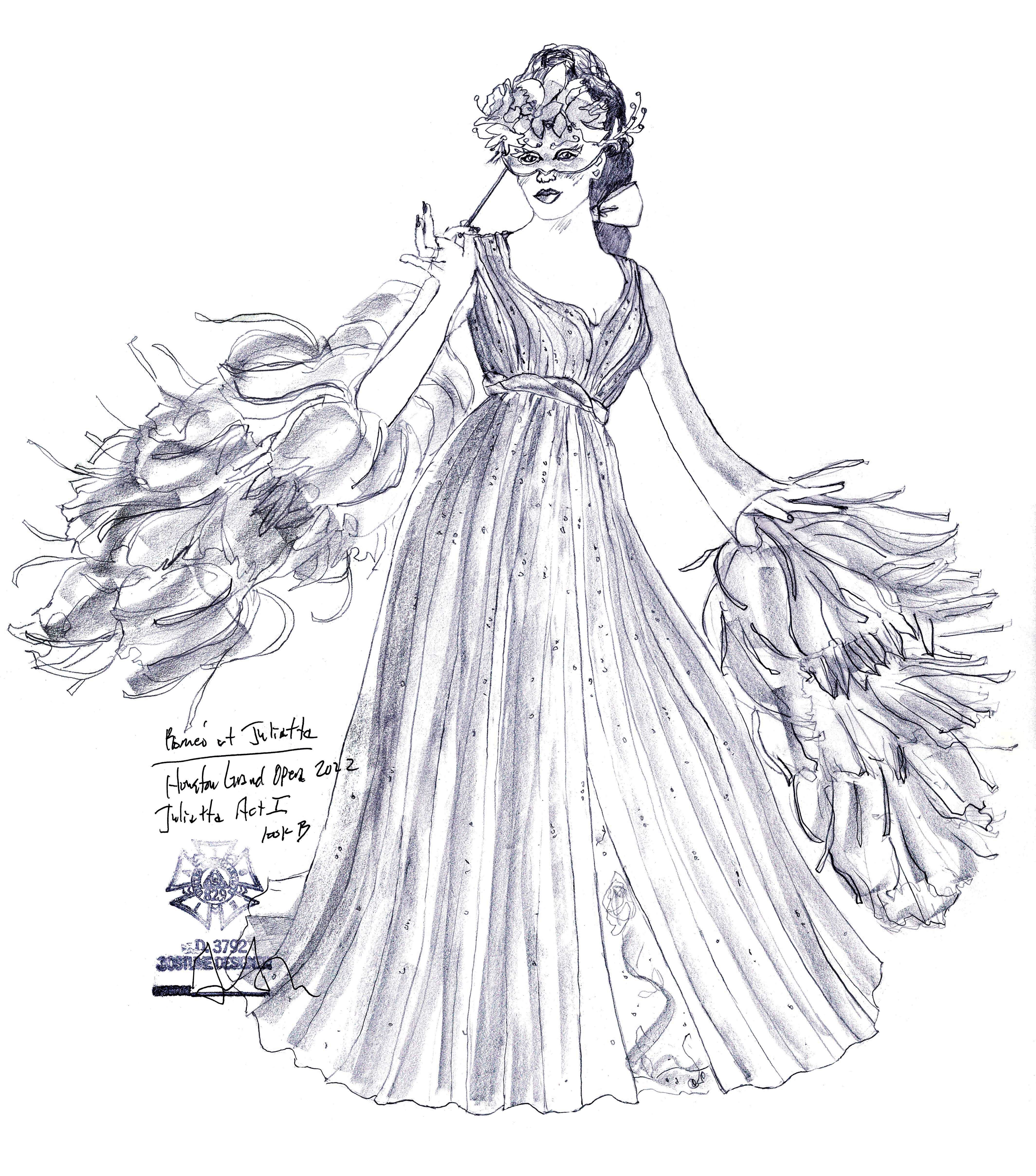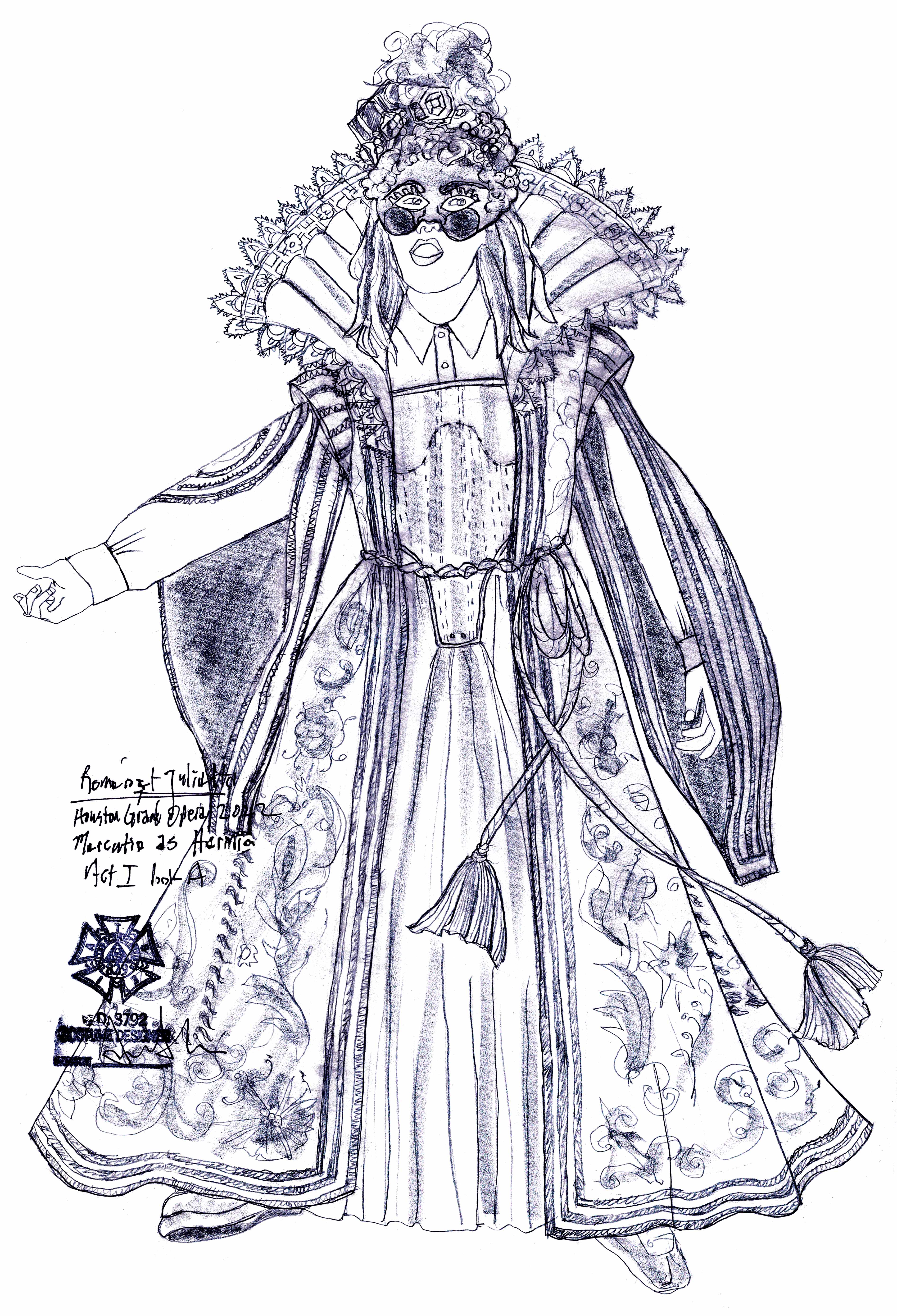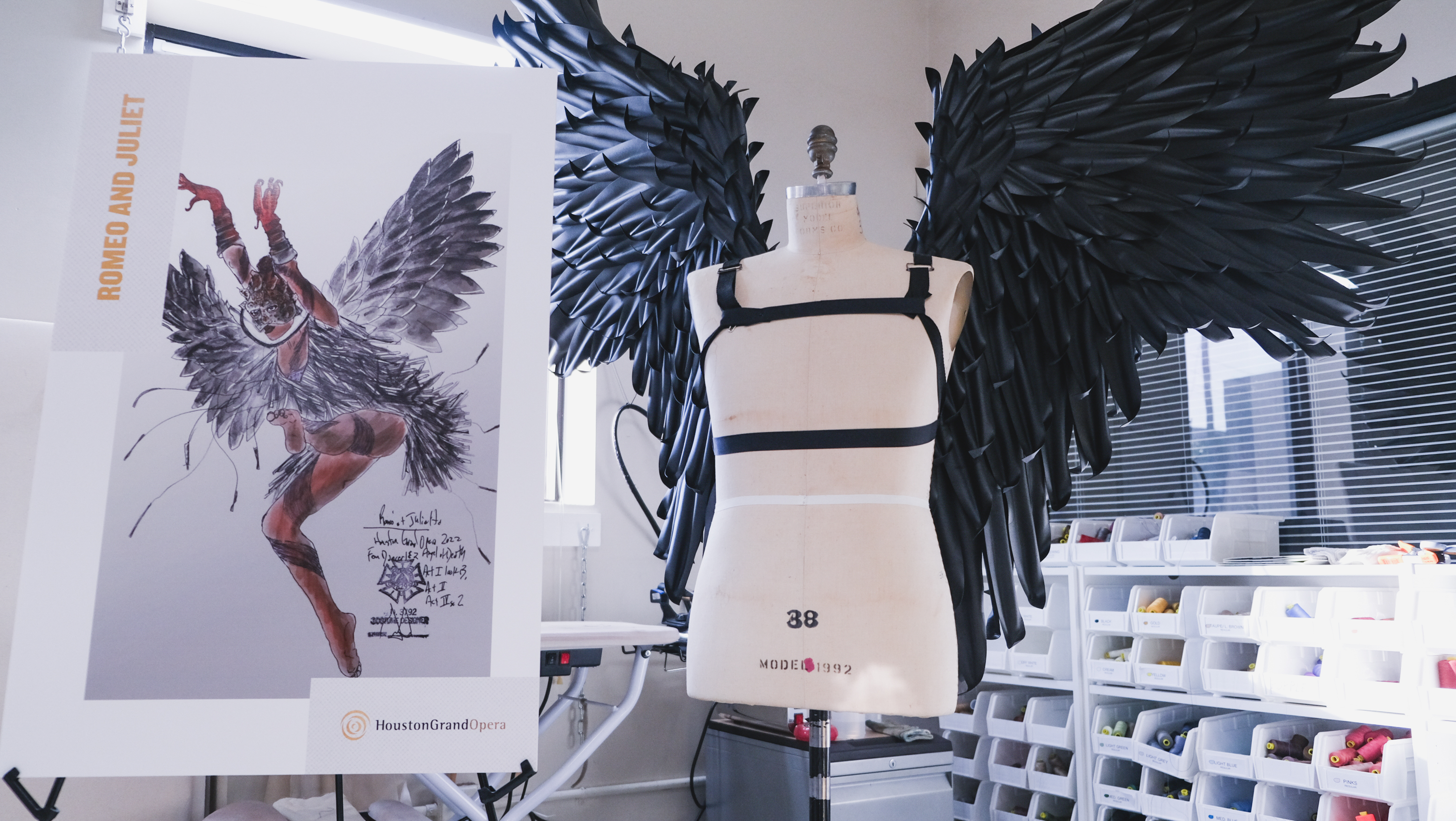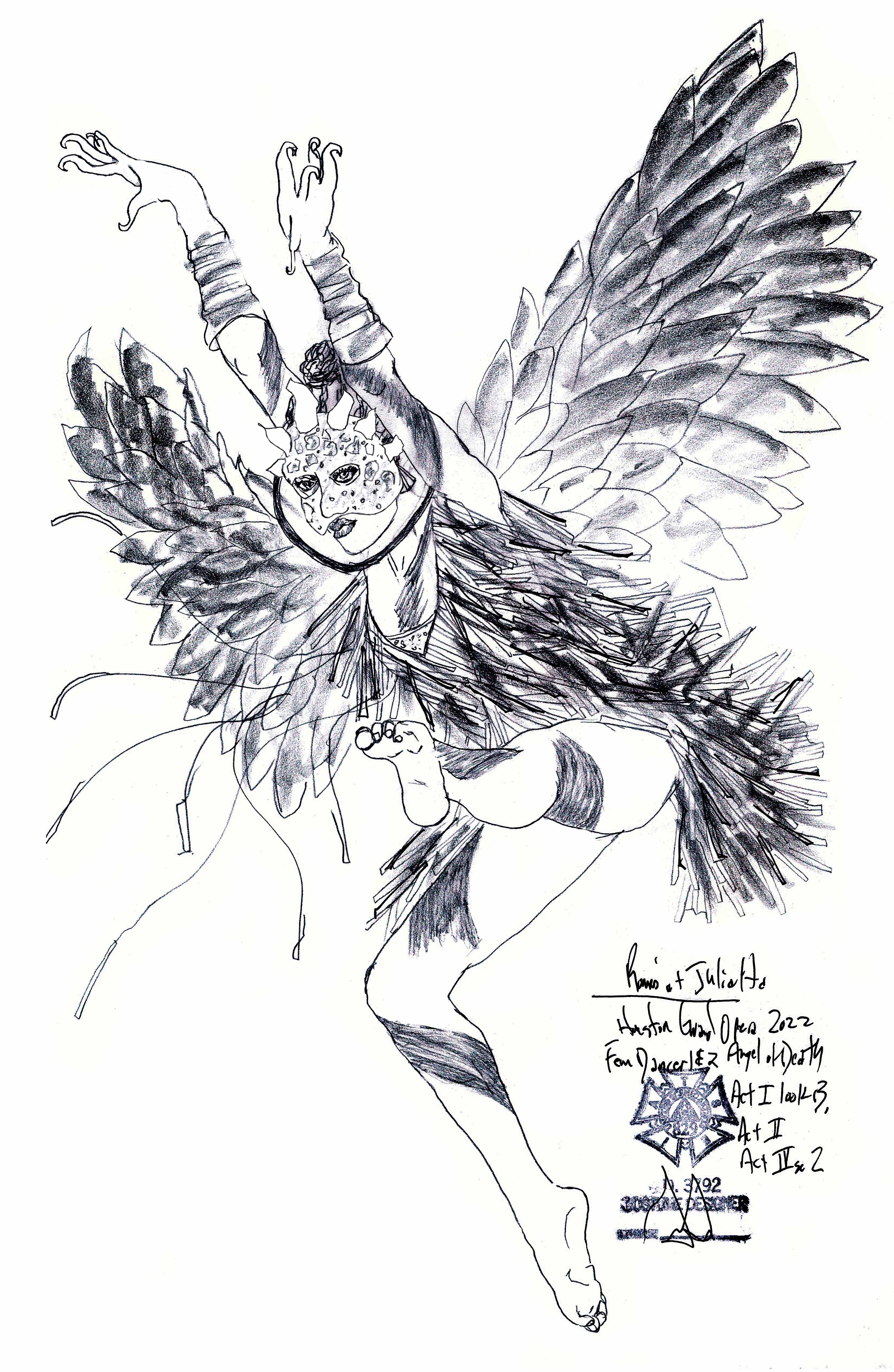Behind The Seams

HGO’s costume and wig shop, with its massive vault door, looks like it used to be a bank. The shop was set up after Hurricane Harvey flooded the Wortham Theater Center and destroyed countless treasures, along with the machines and tools needed to create them in the first place. Since then such things have been made and stored off-site, in a safer space located in a warehouse district east of downtown. The building’s vault door—which guards the fitting room—certainly feels secure.
But COVID-19 has presented HGO’s costume and wig team with a whole new set of problems. All season the pandemic has required them to think quickly, to bend, to compromise. And the timing of the Omicron surge has added new layers of complications as they prepare for spring’s Romeo and Juliet production. “It’s a pandemic thing,” HGO Head of Costumes Norma Cortez explains. “Most of the time that we’re doing a new project, the designer gets to be here in Houston. We gather all of the information, and then we all go to New York to do all of the purchasing for fabrics.” But for now, all of that has gone out the window.

Instead, the costume designer for the production, Gregory Gale, has sent his sketches from New York, and he and Cortez have been meeting online. “He was able to get an assistant,” Cortez says, “so we’re working with them to get all of the fabrics, all of the swatches, and everything, to Houston.” It’s been unusual, but then, Cortez, who’s been with HGO for 23 years, knows how to adapt. When Harvey hit, she herself carried as many costumes as she could out of the Wortham to safety. She has more experience adapting to disaster than she should have. She knows she’s going to make it work.
In the best of times, building costumes for any HGO production is a long process. On the February day of our visit, few pieces for Romeo and Juliet are ready, but we do see capes, accessories, and some impressively large black wings for the dancers. And then there’s the abundance of fabrics, rolls of leather that will become belts and holsters, and racks full of mock-ups.
Artists have been coming in to be measured for plain gray-white versions of their costumes, with Gale attending virtually to provide advice and approval. These mock-ups, full of pins and with notes written directly on the fabric, are hung throughout the shop. They’re the basis for the final costumes, many of which are already under construction.

Cortez shows us a binder full of Gale’s sketches, stapled with fabric swatches. She shows us Gale's sketch for a uniform to be worn by the character Gregorio, then its mock-up, measured for baritone Blake Denson. Nearby, two costumers are sewing the piece. The work is detailed and elegant: the jacket’s silky patterned lining contrasts subtly with its darker exterior, and the half-made pants are sewn with a handsome strip of blue down the seam.
It takes more than one shop to produce these costumes. Gregorio’s uniform is a prototype that will be sent off to New York, where another costumer will sew a version tailored for tenor Carlos Enrique Santelli, who portrays Tybalt, and 20 more uniformed performers in the chorus. Other costumes will be created in shops as far away as Thailand. There are dyers and a costume painter.
Cortez shows us Gale’s sketches for the gown that will require painting: Juliet’s dress. She has a lot to say about this dress, a complex feat of design and engineering. She turns page after page of the binder, through layer after layer of the garment, each showcasing different pieces that will be traded out to create the appearance of different dresses. The design includes an intricately painted silver gown, as well as blue and green dresses, one with sleeves that flair at the wrists to conceal an upcoming wardrobe change, another with sleeves that come off completely. Cortez shows us the fabric, which needs to be treated, pre-steamed, and prepped for dyes and paint and, finally, something resembling blood.
You cannot talk about Juliet’s dress without talking about blood. And as Cortez explains, you can’t have one clean version and another stained version. You have to be able to stain the dress with blood, wash it clean, and then wear it again, like new. Such a requirement eliminates a surprising number of possible fabrics.
“I think that was one of the biggest challenges, trying to figure out which fabrics we’ll be able to use,” Cortez explains. The team bought and tested many types, she says, “and then we told the designer: this is the fabric that will take it, and this is the fabric that will get really damaged if we do that… We had to make sure it was the right blood, it was the right fibers, and it was to the liking of the designer.”

Adding to these challenges, HGO will require three different versions of the dress: one for soprano Adriana González, who is performing Juliet in the main cast, another for soprano Elena Villalón, who will serve as cover and alternate cast, and a third for Juliet’s dancer body-double. Each piece is as complex as it is exquisite; each presents its own challenges. And unlike the uniforms, whose prototypes can be reliably duplicated by skilled collaborators, all of the principal cast costumes must be painstakingly assembled by Cortez and her staff, who are hopeful that as Omicron declines, Gale will be able to travel to Houston for final fittings.
The mood in the shop is one of busy excitement. Everywhere, costumes for Romeo and Juliet are being cut and prepared, with work on pieces for spring’s other opera, Turandot, happening at the same time.
The creative energy makes for a bright and friendly place, welcoming even if everyone appears almost
too busy to look up from their fabric and tools.
This is where it starts: the creation of the gorgeous costumes that will sweep across the Wortham stage, adding color and life and helping the cast transport audiences to another time and place. “It takes a lot of time to build any costume that we have. Especially gowns,” Cortez shares, adding: “It’s going to look beautiful.”